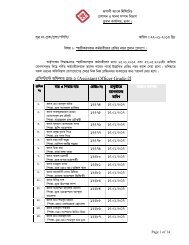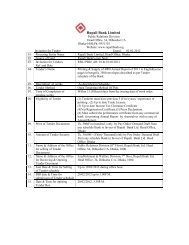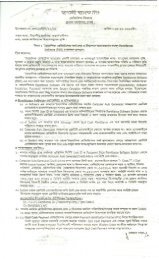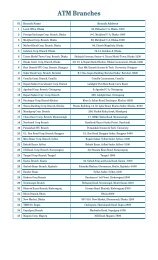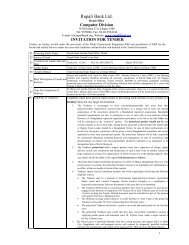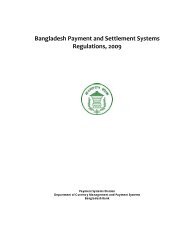Batch User Guide produced by CRIF - Janata Bank
Batch User Guide produced by CRIF - Janata Bank
Batch User Guide produced by CRIF - Janata Bank
You also want an ePaper? Increase the reach of your titles
YUMPU automatically turns print PDFs into web optimized ePapers that Google loves.
3.4 WHY SHOULD I SEND REQUESTS<br />
One of the strenghts of the system is that it does not only report unpaid amounts (which can be<br />
used to assess existing credit risk) nor does it only report granted amounts (which can be used<br />
to access potential credit risk), but also usage and requests, which can be used to assess risk of<br />
over-exposure. By submitted requested credit, the system also insures that if someone goes to<br />
three institutions the same day to ask credit, they don‟t all provide it without knowing the same<br />
credit has been requested elsewhere.<br />
3.5 WHY SHOULD I SEND REFUSED/REJECTED<br />
We saw in 3.4 how credit requests can be used to assess over-exposure risk. By the same token,<br />
once a credit request is refused or rejected, such risk is no longer real. It is good practice,<br />
therefore, to provide the notification of refused/rejected credit to keep the credit history up to<br />
date.<br />
It is understandable, however, that not all institutions are immediately equipped to perform this<br />
notification. Therefore the system is set to automatically archive open requests after one year.<br />
3.6 HOW IS THE INFORMATION CONTRIBUTED<br />
While we have a specific paragraph (please see section 4.2) that details the technical<br />
specifications of how the information is sent, at the very high level please note that each<br />
contributor must send, with each contribution, 2 separate files.<br />
1) A file containing Subject information<br />
2) A file containing Contract information<br />
Each file will be a space delimited .txt file with the structure defined in section 5<br />
3.7 WHAT IS THE SINGLE MOST IMPORTANT THING TO REMEMBER<br />
The key aspect to keep in mind is that each contributing institution must be able to manage<br />
internally a unique identification code that refers explicitly to a single subject as well as a unique<br />
identification code that refers explicitly to a single contract. Neither of these number is the CIB<br />
Borrower Code that existed in the previous system.<br />
CIB Code and FI Contract/Subject code Definition<br />
Every Subject and Contract record contributed (online or batch) to the system needs to be<br />
uniquely identified. This is achieved <strong>by</strong> assigning an unique code to each record. Codes are<br />
divided into two groups: <strong>User</strong> and CIB.<br />
FI codes – (FI Subject code or FI Contract code) are those codes contributed <strong>by</strong> the <strong>User</strong>.<br />
These codes either generate new entries in the database (if the system does not<br />
recognize the information as already present within the DB) or are linked to already<br />
existing information. FI codes must be always<br />
unique for a given FI.<br />
CIB codes – sometimes also referred as DB<br />
codes - (CIB Subject code or CIB Contract code)<br />
are unique codes at the system level. These<br />
codes are used to group the identical<br />
information contributed <strong>by</strong> different FIs<br />
9 of 92





